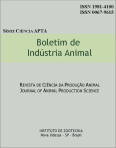Beta-adrenergic agonists as additive in beef cattle
DOI:
https://doi.org/10.17523/bia.v71n4p396Keywords:
steers, ractopamine, finishing, zilpaterolAbstract
The agonists receptor beta-adrenergic (β-AA) are present in virtually all types of mammalian cells and are stimulated by catecholamines (epinephrine and norepinephrine) produced by the organism itself. The β-AA agonists are synthetic substances with similar structure to these amines. When provided in the diet they alter the body composition of animals, affecting the distribution of nutrients toward to protein deposition, and decreasing lipogenesis. Although the mechanisms of action are not fully understood, these may cause morphological and physiological changes such as increased blood flow decrease in plasma insulin, decreased lipogenesis, and muscle hypertrophy mainly in type II fibers. We also observed changes in motility and secretions grastointestinal tract, beyond the direct influence on the rumen bacteria, altering the digestibility of the diet. The β-AA agonists released in some countries for use in beef cattle are ractopamine hydrochloride and zilpaterol hydrochloride. According to literature data, the inclusion of these additives in the diet of feedlot cattle has been associated with an increase infeed efficiency with the increase in daily weight gain and with equal or lower feed intake. Carcass characteristics improvement was verified in carcass weight, and increased loin eye area, but with the possibility to decrease the subcutaneous fat thickness and marbling. Reviews in sensory panel of meat from animals consuming β-AA agonists showed decreased tenderness and juiciness. Thus β-AA improve performance and carcass characteristics, but more studies are needed to confirm whether they have negative influence on the organoleptic characteristics of the meat.Downloads
Downloads
Published
Issue
Section
License
Os autores não serão remunerados pela publicação de trabalhos, pois devem abrir mão de seus direitos autorais em favor deste periódico. Por outro lado, os autores ficam autorizados a publicar seus artigos, simultaneamente, em repositórios da instituição de sua origem, desde que citada a fonte da publicação original seja Boletim de Indústria Animal. A revista se reserva o direito de efetuar, nos originais, alterações de ordem normativa, ortográfica e gramatical, com vistas a manter o padrão culto da língua e a credibilidade do veículo. Respeitará, no entanto, o estilo de escrever dos autores. Alterações, correções ou sugestões de ordem conceitual serão encaminhadas aos autores, quando necessário. Nesses casos, os artigos, depois de adequados, deverão ser submetidos a nova apreciação. As opiniões emitidas pelos autores dos artigos são de sua exclusiva responsabilidade. Todo o conteúdo deste periódico, exceto onde está identificado, está licenciado sob a Licença Creative Commons Attribution (CC-BY-NC). A condição BY implica que os licenciados podem copiar, distribuir, exibir e executar a obra e fazer trabalhos derivados com base em que só se dão o autor ou licenciante os créditos na forma especificada por estes. A cláusula NC significa que os licenciados podem copiar, distribuir, exibir e executar a obra e fazer trabalhos derivados com base apenas para fins não comerciais.













